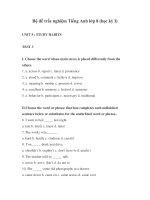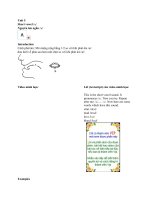BDNC unit 5 Proper names
Bạn đang xem bản rút gọn của tài liệu. Xem và tải ngay bản đầy đủ của tài liệu tại đây (80.61 KB, 7 trang )
UNIT 5 – Proper names
Task 1: Find the generic term for the following words
STT Specific
Superordinate/generic
Vietnamese
word
1
pens/pencils
and stationery
văn phòng phẩm
papers
2
garment and textile
clothing
hàng dệt may
3
needles and thread
sewing kit
kim chỉ
4
Newspapers,
radio, media
Các cơ quan báo đài
TV
5
eating and drinking
6
mats,
cuisine
pillows, bedding
ẩm thực
chăn, ga, gối, đệm
cushion
7
packages and wraps
wrappings
đồ gói bọc
8
jars, jugs, bottles,
container
chai, lọ, bình
9
cups, sauces, dishes
dinnerware
ấm chén bát đĩa
10
knifes, forks, spoons
cutlery
dao dĩa thìa muôi
11
washing
powder
/ laundry detergent
nước tẩy, bột giặt
liquid
12
cigar, cigarette / pipe
tobacco
thuốc lá
13
button / zipper / lock
clothes fastening
ghim, khóa, móc,
chốt
14
saucepan, pan, pots cookware
nồi niêu xoong chảo
and pans
15
china,
ceramic, pottery
gốm, sứ, đất nung
terracotta
Task 2: Try to translate the names of the following organizations into English.
Then compare with the official names on their websites. In each case, provide
the abbreviation of the organization. The first one has been done for you as an
example.
1
Vietnamese
English
Bộ Giáo dục và Đào tạo
Ministry of Education and Training
(MOET)
2
3
Bộ Lao động, Thương binh Ministry of Labor, Invalids and Social
và Xã hội
Affairs
Bộ Ngoại giao
Foreign Office (Ministry of Foreign
Affairs)
4
Bộ Nội vụ
Home Office (Ministry of Home
Affairs)
5
Bộ Tư pháp
6
Bộ Văn hoá, Thể thao và Du Ministry
lịch
7
Department of Justice
of
Culture,
Sports
and
Tourism
Học viện Âm nhạc Quốc gia Vietnam National Academy of Music
Việt Nam
8
Học viện Hành chính Quốc National
gia
9
Academy
of
Administration
Học viện Ngoại giao Việt Diplomatic Academy of Vietnam
Public
Nam
10
11
Thanh tra Chính phủ Việt The
Government
Inspectorate
of
Nam
Vietnam
Tổng cục Du lịch Việt Nam
Vietnam National Administration of
Tourism
12
Tổng cục Thống kê
General Statistics Office
13
Tổng cục Thuế
General Department of Taxation
14
Viện Kiểm sát Nhân dân Tối The Supreme People's Procuracy of
cao Việt Nam
15
Vietnam
Viện Hàn lâm Khoa học Xã Vietnam Academy of Social Sciences
hội Việt Nam
Task 3: Translate the following sentences into English, paying greater
attention to the proper names that have been Vietnamized or naturalized:
1. Đối thủ tiếp theo của ông Giáp là tướng bốn sao Ble-dô vừa đến Sài Gòn
nhậm chức tổng chỉ huy trung tuần tháng 5 đúng vào dịp ông Giáp nhận quân
hàm Đại tướng.
Mr. Giap's next opponent is the four-star General Bledo, who has just arrived
in Saigon to take over the position of commander-in-chief in mid-May on the
occasion that Giap received the rank of General.
2. Hai mươi chín năm sau, ngày 8 tháng 4 năm 1983 trên tờ báo Pháp Người
quan sát mới, người ta thấy 2 ký giả Pháp là Bu-đa-ren và Ca-vich-li-ô-li viết
bài nhan đề “Tướng Giáp suýt thua trận Điện Biên Phủ”, kể chi tiết diễn biến
của việc thay đổi phương châm tác chiến của ta.
Twenty-nine years later, on April 8, 1983, in the French newspaper New
Observer, two French journalists, Budaren and Cavichlioli, were seen writing
an article titled "General Giap almost lost the battle of Dien Bien Phu",
detailing the evolution of our change of strategy.
3. Trong Lĩnh ngoại đại đáp của Chu Khứ Phi thời Tống có chép về người Việt
như sau ―Người nước đó mặc áo đen, nhuộm răng đen, búi tóc, đi chân đất, bất
kể sang hèn‖. Ghi chép này cho thấy ít ra từ nửa sau thế kỉ XII người Việt ai
cũng nhuộm răng đen. Ngoài ra, trong An Nam chí nguyên do Cao Hùng
Trưng viết thế kỉ XVII có ghi về tục lệ của người Việt trước thế kỉ XV với đoạn
chép “Người ở đó hoặc búi tóc hoặc cắt tóc, xăm mình, chân đất, miệng đỏ,
răng đen, kẻ hèn sang đều ăn trầu”.
In the Great Replies by Zhu Qufei, during the Song Dynasty, it was written
about the Vietnamese as follows: 'People of that country wear black clothes,
dye their teeth black, bun their hair, walk barefoot, regardless of luxury'. This
record shows that at least from the second half of the 12th century, all
Vietnamese people dyed their teeth black. In addition, in Annam Chi Nguyen
written by Kaohsiung Trung in the 17th century, there is a record of the
Vietnamese custom before the 15th century with the passage "People there
either bun their hair or cut their hair, tattooed, barefoot, red mouth. , black
teeth, cowards eat betel nuts."
4. Đánh giá về Hoàng Thành Thăng Long, Giáo sư Inoue Kazuto (Đại học
Minh Trị, Tokyo, Nhật Bản) cho rằng: “Qua những di tích kiến trúc, chúng ta
biết được rằng lúc đó trình độ văn hóa của dân tộc Việt Nam rất cao”. Trong khi
đó, Phó Giáo sư–Tiến sỹ Nishimura Masanari (Đại học Kansai, Osaka, Nhật
Bản) khẳng định: “Chắc chắn đây là trường hợp kinh đô lâu đời nhất trong khu
vực Châu Á và có lẽ chỉ La Mã mới so sánh được”.
Evaluating the Imperial Citadel of Thang Long, Professor Inoue Kazuto (Meiji
University, Tokyo, Japan) said: “Through the architectural monuments, we
know that at that time the cultural level of the Vietnamese people was very
high". Meanwhile, Associate Professor-Dr. Nishimura Masanari (Kansai
University, Osaka, Japan) asserts: “This is certainly the case of the oldest
capital in Asia and perhaps only Rome can be comparable”.
5. Để sinh động hơn cho nhận thức các giá trị của Di sản, xin dẫn lại một số
đánh giá của một số học giả quốc tế năm 2004 về giá trị to lớn của khu di tích
Hồng thành Thăng Long sau khi họ đến thăm cuộc khai quật lớn của Viện
Khảo cổ học Việt Nam tại 18 Hoàng Diệu đã được công bố (Hội Khoa học
Lịch sử Việt Nam 2004). GS. Philippe Papin (Viện Cao học Thực hành
Sorbonne, Cộng hòa Pháp): “Trên thế giới, có nhiều di tích cổ hơn và hiện
trạng của chúng tốt hơn, nhưng liệu chúng ta có thể tìm thấy nơi nào đó đã tồn
tại và tiếp nối trong suốt hơn một thiên niên kỷ”.
To make the perception of heritage values more vivid, I would like to quote
some evaluations of some international scholars in 2004 about the great value
of The Imperial Citadel of Thang Long after they visited the excavation. The
great excavation of the Vietnam Institute of Archeology at 18 Hoang Dieu has
been announced (Vietnam Historical Science Association 2004). GS. Philippe
Papin (Sorbonne Institute for Practical Graduate Studies, French Republic):
“In the world, there are more ancient monuments and their condition is better,
but can we find somewhere that already exists and continues to exist for more
than a millennium”.









